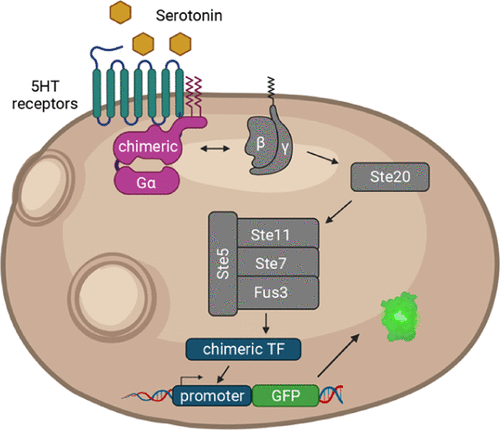Our official English website, www.x-mol.net, welcomes your
feedback! (Note: you will need to create a separate account there.)
Serotonin G Protein-Coupled Receptor-Based Biosensing Modalities in Yeast
ACS Sensors ( IF 8.2 ) Pub Date : 2022-04-22 , DOI: 10.1021/acssensors.1c02061 Bettina Lengger 1 , Emma E Hoch-Schneider 1 , Christina N Jensen 1 , Tadas Jakočiu Nas 1 , Anja A Petersen 2 , Thomas M Frimurer 2 , Emil D Jensen 1 , Michael K Jensen 1
ACS Sensors ( IF 8.2 ) Pub Date : 2022-04-22 , DOI: 10.1021/acssensors.1c02061 Bettina Lengger 1 , Emma E Hoch-Schneider 1 , Christina N Jensen 1 , Tadas Jakočiu Nas 1 , Anja A Petersen 2 , Thomas M Frimurer 2 , Emil D Jensen 1 , Michael K Jensen 1
Affiliation

|
Serotonin is a key neurotransmitter involved in numerous physiological processes and serves as an important precursor for manufacturing bioactive indoleamines and alkaloids used in the treatment of human pathologies. In humans, serotonin sensing and signaling can occur by 12 G protein-coupled receptors (GPCRs) coupled to Gα proteins. In yeast, human serotonin GPCRs coupled to Gα proteins have previously been shown to function as whole-cell biosensors of serotonin. However, systematic characterization of serotonin biosensing modalities between variant serotonin GPCRs and application thereof for high-resolution serotonin quantification is still awaiting. To systematically assess GPCR signaling in response to serotonin, we characterized reporter gene expression at two different pHs of a 144-sized library encoding all 12 human serotonin GPCRs in combination with 12 different Gα proteins engineered in yeast. From this screen, we observed changes in the biosensor sensitivities of >4 orders of magnitude. Furthermore, adopting optimal biosensing designs and pH conditions enabled high-resolution high-performance liquid chromatography-validated sensing of serotonin produced in yeast. Lastly, we used the yeast platform to characterize 19 serotonin GPCR polymorphisms found in human populations. While major differences in signaling were observed among the individual polymorphisms when studied in yeast, a cross-comparison of selected variants in mammalian cells showed both similar and disparate results. Taken together, our study highlights serotonin biosensing modalities of relevance to both biotechnological and potential human health applications.
中文翻译:

酵母中基于血清素 G 蛋白偶联受体的生物传感方式
血清素是参与众多生理过程的关键神经递质,是制造用于治疗人类病理的生物活性吲哚胺和生物碱的重要前体。在人类中,血清素传感和信号传导可以通过与 Gα 蛋白偶联的 12 G 蛋白偶联受体 (GPCR) 发生。在酵母中,与 Gα 蛋白偶联的人血清素 GPCR 先前已被证明可作为血清素的全细胞生物传感器。然而,不同血清素 GPCR 之间血清素生物传感方式的系统表征及其在高分辨率血清素定量中的应用仍在等待。为了系统地评估响应血清素的 GPCR 信号传导,我们对编码所有 12 种人类血清素 GPCR 以及酵母中工程化的 12 种不同 Gα 蛋白的 144 大小的文库在两种不同 pH 下的报告基因表达进行了表征。从这个屏幕中,我们观察到生物传感器灵敏度的变化 > 4 个数量级。此外,采用最佳的生物传感设计和 pH 条件,可以对酵母中产生的血清素进行高分辨率、高性能液相色谱验证的传感。最后,我们使用酵母平台来表征在人群中发现的 19 种血清素 GPCR 多态性。虽然在酵母研究中观察到各个多态性之间信号传导存在重大差异,但对哺乳动物细胞中选定变体的交叉比较显示出相似和不同的结果。总而言之,我们的研究强调了与生物技术和潜在人类健康应用相关的血清素生物传感方式。
更新日期:2022-04-22
中文翻译:

酵母中基于血清素 G 蛋白偶联受体的生物传感方式
血清素是参与众多生理过程的关键神经递质,是制造用于治疗人类病理的生物活性吲哚胺和生物碱的重要前体。在人类中,血清素传感和信号传导可以通过与 Gα 蛋白偶联的 12 G 蛋白偶联受体 (GPCR) 发生。在酵母中,与 Gα 蛋白偶联的人血清素 GPCR 先前已被证明可作为血清素的全细胞生物传感器。然而,不同血清素 GPCR 之间血清素生物传感方式的系统表征及其在高分辨率血清素定量中的应用仍在等待。为了系统地评估响应血清素的 GPCR 信号传导,我们对编码所有 12 种人类血清素 GPCR 以及酵母中工程化的 12 种不同 Gα 蛋白的 144 大小的文库在两种不同 pH 下的报告基因表达进行了表征。从这个屏幕中,我们观察到生物传感器灵敏度的变化 > 4 个数量级。此外,采用最佳的生物传感设计和 pH 条件,可以对酵母中产生的血清素进行高分辨率、高性能液相色谱验证的传感。最后,我们使用酵母平台来表征在人群中发现的 19 种血清素 GPCR 多态性。虽然在酵母研究中观察到各个多态性之间信号传导存在重大差异,但对哺乳动物细胞中选定变体的交叉比较显示出相似和不同的结果。总而言之,我们的研究强调了与生物技术和潜在人类健康应用相关的血清素生物传感方式。









































 京公网安备 11010802027423号
京公网安备 11010802027423号